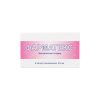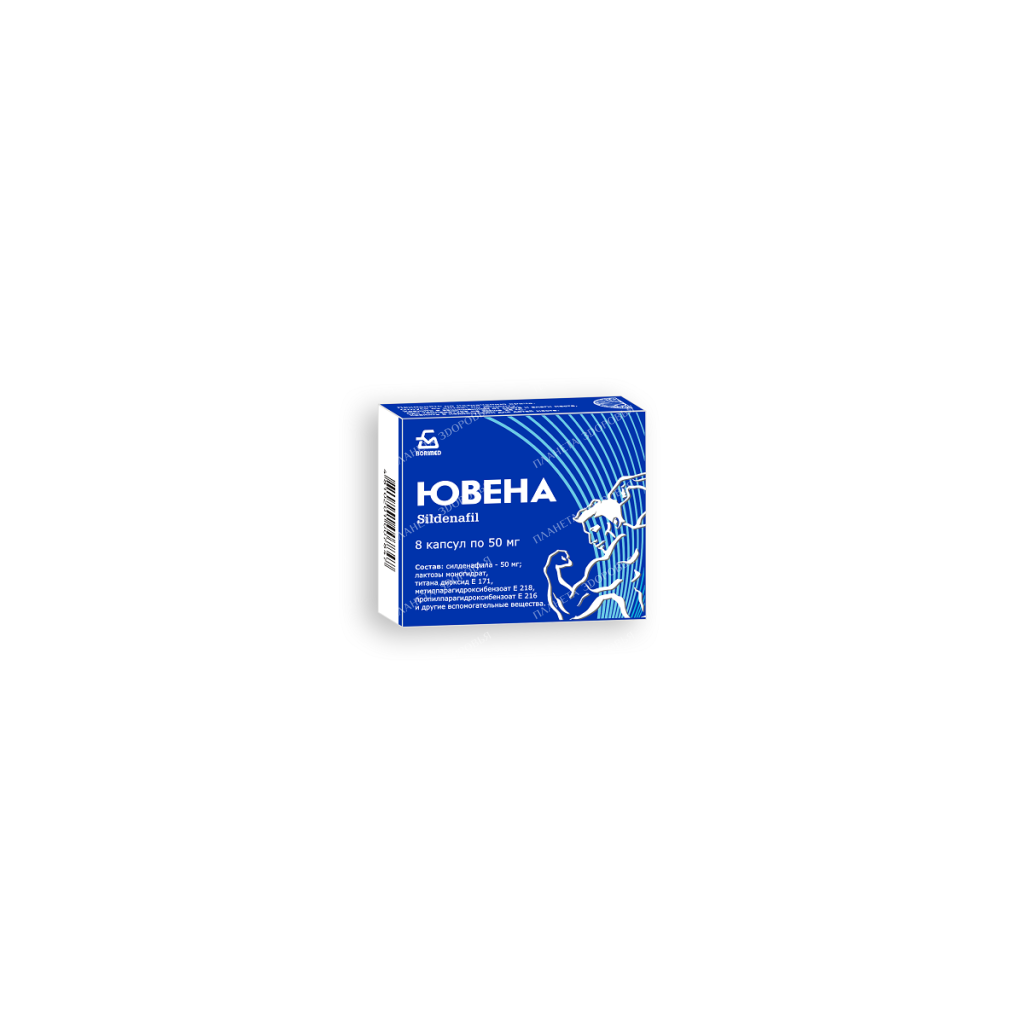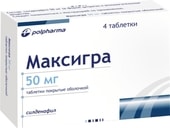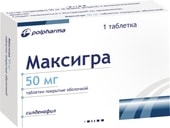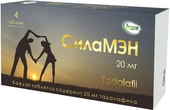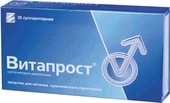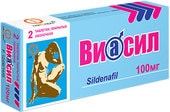Name:
Juvena caps.50mg in a cell. pack No. 4×2
Description:
Capsules are hard gelatinous cylindrical shapes with hemispherical ends, white. The contents of the capsules are white or white with a grayish tint powder. Release form capsules Dosage 50 mg Pharmacological action Pharmacodynamics Sildenafil is intended for oral therapy of erectile dysfunction. Under natural conditions, i.e. in the presence of sexual stimulation, it restores impaired erectile function by increasing blood flow to the penis. The physiological mechanism underlying penile erection involves the release of nitric oxide (NO) in the corpus cavernosum upon sexual stimulation. The resulting nitric oxide activates the enzyme guanylate cyclase, which leads to an increase in the level of cyclic guanosine monophosphate (cGMP), which causes smooth muscle relaxation in the cavernous body and an increase in blood flow. Sildenafil is a selective inhibitor of cGMP-specific phosphodiesterase type 5 (PDE-5), which is responsible for the breakdown of cGMP in the cavernous body. Sildenafil has a peripheral effect on erection. Sildenafil does not have a direct relaxing effect on the isolated human corpus cavernosum, but actively enhances the relaxing effect of NO on this tissue. Upon activation of the NO/cGMP cascade observed during sexual stimulation, inhibition of PDE-5 by sildenafil leads to an increase in the level of cGMP in the cavernous body. Thus, sexual stimulation is necessary for the development of the desired pharmacological action of sildenafil. Pharmacokinetics Absorption Sildenafil is rapidly absorbed. The maximum observed plasma concentrations when taking sildenafil orally on an empty stomach are achieved within 30-120 minutes (median 60 minutes). Absolute bioavailability averages about 41% (25%-63%). After taking the drug orally in the recommended dose range (25-100 mg), AUC and Cmax of sildenafil increase in proportion to the dose. When taking sildenafil with food, its absorption rate decreases, while the time to reach the maximum concentration (tmax) increases by an average of 60 minutes, and Cmax decreases by an average of 29%. Distribution The volume of distribution of sildenafil at steady state (Vd) averages 105 liters, indicating its distribution in tissues. The maximum total plasma concentration of sildenafil after a single dose of the drug orally at a dose of 100 mg averages about 440 ng / ml (coefficient of variation – 40%). Since the binding of sildenafil (and its main circulating N-desmethyl metabolite) to plasma proteins reaches 96%, the average maximum concentration of the free fraction of sildenafil in plasma is 18 ng / ml (38 nM). Plasma protein binding does not depend on the total concentration of the drug. In healthy volunteers, 90 minutes after a single dose of sildenafil at a dose of 100 mg, less than 0.0002% of the dose of the drug was determined in the ejaculate (average – 188 ng). Metabolism Sildenafil is metabolized primarily by CYP3A4 (primary route) and CYP2C9 (secondary route) microsomal liver isoenzymes. The main circulating metabolite is formed as a result of N-demethylation of sildenafil. This metabolite has a phosphodiesterase selectivity profile similar to that of sildenafil, and its activity against PDE-5 in vitro is approximately 50% of the activity of the main substance. Plasma concentrations of this metabolite are approximately 40% of the concentration of sildenafil. The N-demethylated metabolite undergoes further metabolism; its terminal half-life is about 4 hours. Withdrawal The total clearance of sildenafil from the body is 41 l / h, the half-life in the terminal phase is 3-5 hours. After oral or intravenous administration, sildenafil is excreted as metabolites, mainly in the feces (about 80% of the oral dose) and to a lesser extent in the urine (about 13% of the oral dose). Pharmacokinetics in special categories of patients Elderly patients In healthy elderly volunteers (65 years and older), the clearance of sildenafil is reduced, and the concentration of sildenafil and the active N-desmethyl metabolite in plasma is approximately 90% higher than its level in healthy young volunteers (18- -45 years). Due to age-related differences in the binding of the drug to plasma proteins, the corresponding increase in the concentration of free sildenafil in plasma was approximately 40%. Renal insufficiency In volunteers with mild to moderate renal insufficiency (creatinine clearance = 30-80 ml / min), the pharmacokinetic parameters of sildenafil with a single oral administration (at a dose of 50 mg) did not change. The mean values of AUC and Cmax of the N-desmethyl metabolite increased to 126% and 73%, respectively, compared with volunteers of the same age without impaired renal function. However, due to significant interindividual variability, these differences were not statistically significant. In volunteers with severe renal insufficiency (creatinine clearance <30 ml / min), the clearance of sildenafil decreased, which led to an increase in AUC and Cmax by an average of 100% and 88%, respectively, compared with these indicators in patients of the same age group with normal function kidneys. In addition, the AUC and Cmax values of the N-desmethyl metabolite were increased by 200% and 79%, respectively. Liver failure In volunteers with mild to moderate liver cirrhosis (Child-Pugh class A and E), sildenafil clearance decreased, resulting in an increase in AUC (84%) and Cmax (47%) compared with these indicators in patients of the same age group with normal liver function. The pharmacokinetics of sildenafil have not been studied in patients with severe hepatic impairment. Indications for use Sildenafil is indicated for adult men with erectile dysfunction, characterized by an inability to achieve or maintain an erection level necessary for satisfactory intercourse. For the effective action of the drug, sexual stimulation is necessary. Dosage and administration Capsules are intended for oral administration. For most patients, the recommended dose, taken as needed approximately 1 hour before sexual activity, is 50 mg. Depending on the effectiveness and tolerability of the drug, the dose may be increased to the maximum recommended dose of 100 mg or reduced to 25 mg. The maximum recommended dose is 100 mg. The frequency of taking the maximum recommended dose is 1 time per day. Juven capsules 50 mg and 100 mg cannot be divided into parts. If it is necessary to prescribe a dose of sildenafil 25 mg, another drug should be used. Application in patients with impaired renal function In patients with impaired renal function of mild to moderate severity (creatinine clearance in the range of 30-80 ml / min), dose adjustment is not required. In connection with the decrease in the clearance of sildenafil in patients with severe renal impairment (creatinine clearance <30 ml / min), an initial dose of 25 mg should be used. Application in patients with impaired liver function Since the clearance of sildenafil is reduced in patients with impaired liver function (for example, with cirrhosis), it is recommended to use an initial dose of 25 mg. Use in patients taking other drugs With the exception of ritonavir, whose simultaneous administration with sildenafil is contraindicated, an initial dose of sildenafil 25 mg is recommended for patients receiving concomitant inhibitors of the CYP3A4 isoenzyme (for example, erythromycin, ketoconazole, cimetidine). In order to minimize the likelihood of developing postural hypotension, patients should be in a stable condition during treatment with ?-blockers before starting the use of sildenafil. In addition, in such cases, it is recommended to start the use of sildenafil with a dose of 25 mg. Use in children Sildenafil is not indicated for use in children and adolescents (under 18 years of age). Use in Elderly Patients Dose adjustment of sildenafil in elderly patients is not required. For patients over 65 years of age, it is recommended to start taking sildenafil with a dose of 25 mg. PrecautionsTo diagnose erectile dysfunction, determine their possible causes and select adequate treatment, it is necessary to take a complete medical history and conduct a thorough physical examination. Risk Factors for Cardiovascular Disease Sexual activity poses a certain risk in the presence of heart disease, so before starting any therapy for erectile dysfunction, the doctor may consider it necessary to conduct an examination of the patient's cardiovascular system. Sildenafil has a vasodilatory effect, resulting in a slight transient decrease in blood pressure. Before prescribing sildenafil, the physician should carefully assess the risk of possible adverse vasodilatory effects in patients with relevant diseases, especially against the background of sexual activity. Increased susceptibility to vasodilators has been observed in patients with left ventricular outflow obstruction (eg, aortic stenosis, hypertrophic obstructive cardiomyopathy), as well as the rare multiple system atrophy syndrome, manifested by severe dysregulation of blood pressure from the autonomic nervous system. Juvena enhances the hypotensive effect of nitrates. During the period of post-registration observation, cases of serious cardiovascular complications (including myocardial infarction, unstable angina pectoris, sudden coronary death, ventricular arrhythmia, hemorrhagic stroke, transient ischemic attack, arterial hypertension and hypotension) were reported, which had a temporal relationship with the use Juvena capsules. Most of these patients, but not all of them, had risk factors for cardiovascular events. Many of these adverse events were observed shortly after sexual activity, and some of them were noted after taking sildenafil without subsequent sexual activity. It is not possible to establish the existence of a direct connection between these phenomena and these or other factors. Priapism Drugs for the treatment of erectile dysfunction, incl. sildenafil should be used with caution in patients with an anatomical deformity of the penis (eg, angulation, cavernous fibrosis, or Peyronie's disease) or in patients with diseases predisposing to the development of priapism (such as sickle cell anemia, multiple myeloma, or leukemia). During the post-registration use of sildenafil, there have been reports of the development of prolonged erection and priapism. If the erection lasts more than 4 hours, the patient should seek emergency medical attention. If urgent measures are not taken in priapism, damage to the tissues of the penis and irreversible loss of potency can occur. Co-administration with other PDE-5 inhibitors or other treatments for erectile dysfunction The safety and efficacy of sildenafil when used in combination with other PDE-5 inhibitors or other drugs for the treatment of pulmonary arterial hypertension containing sildenafil, as well as other drugs for the treatment of erectile dysfunction have not been studied , so the use of such combinations is not recommended. Impact on vision Spontaneous reports of cases of visual impairment have been received when taking sildenafil and other PDE-5 inhibitors. Non-arteritic anterior ischernic optic neuropathy (NAION), a rare disease associated with sildenafil and other PDE-5 inhibitors, has been reported in spontaneous reports and observational studies. Patients should be warned that in the event of a sudden visual impairment, stop taking the drug and consult a doctor immediately. Co-administration with ritonavir Co-administration of sildenafil and ritonavir is not recommended. Co-administration with alpha-blockers Since the combined use of sildenafil and alpha-blockers can lead to the development of symptomatic hypotension in some susceptible patients, sildenafil should be administered with caution to patients taking alpha-blockers. The development of this condition is most likely to be observed within 4 hours after taking a dose of sildenafil. In order to minimize the risk of developing orthostatic hypotension, sildenafil therapy should only be started in hemodynamically stable patients using alpha-adrenergic blockers. Consideration should also be given to the use of sildenafil at an initial dose of 25 mg. In addition, physicians should inform patients about what actions to take if symptoms of orthostatic hypotension appear. Effect on blood clotting In vitro studies on human platelets have shown that sildenafil potentiates the antiplatelet effect of sodium nitroprusside. There are no data on the safety of sildenafil in patients with bleeding disorders or acute peptic ulcer, so the use of sildenafil in this group of patients is possible only after a thorough assessment of the benefit / risk ratio. Juvena is not intended for use in women. Due to the content of lactose, the drug is not recommended for patients with congenital galactose intolerance, lactase deficiency or malabsorption of glucose-galactose. Due to the sugar content, the medicinal product is not recommended for patients with fructose intolerance or glucose-galactose malabsorption. Interaction with other drugs The effect of other drugs on sildenafil The excretion of sildenafil is reduced with the simultaneous use of CYP3A4 inhibitors (such as ketoconazole, erythromycin, cemitidine). Despite the fact that with the simultaneous use of sildenafil and CYP3A4 inhibitors, no increase in the frequency of adverse events was observed, the use of the drug at an initial dose of 25 mg should be considered. The simultaneous use of sildenafil and ritonavir, an inhibitor of HIV protease and a strong inhibitor of cytochrome P450, leads to an increase in the maximum concentration of sildenafil in the blood by 4 times (AUC - 11 times). Sildenafil does not affect the pharmacokinetics of ritonavir. The combined use of sildenafil and HIV protease inhibitors is not recommended. The use of sildenafil in a dose of more than 25 mg is contraindicated. Grapefruit juice is a weak inhibitor of CYP3A4 metabolism in the intestinal wall and may cause a moderate increase in plasma levels of sildenafil. A single dose of an antacid (magnesium hydroxide / aluminum hydroxide) without affecting the bioavailability of sildenafil. The pharmacokinetics of sildenafil did not change with its simultaneous use with drugs belonging to the group of CYP2C9 inhibitors (such as tolbutamide, warfarin, phenytoin), the group of CYP2D6 inhibitors (such as selective serotonin reuptake inhibitors, tricyclic antidepressants), the group of thiazide and thiazide-like diuretics, loop and potassium-sparing diuretics, angiotensin-converting enzyme inhibitors, calcium channel blockers, 3-adrenergic antagonists or inducers of CYP450 metabolism (such as rifampicin, barbiturates). The combined use of the endothelin bosentan antagonist and sildenafil reduced the AUC and Cmax of sildenafil by 62.6% and 55.4%, respectively. It can be expected that the simultaneous use of strong inducers of CYP3A4, such as rifampicin, will cause a more pronounced decrease in sildenafil in plasma. Nicorandil has potassium channel activator properties and nitrate-like action. Due to the nitrate component, this drug is potentially able to enter into a clinically significant interaction with sildenafil. The effect of sildenafil on other drugs Sildenafil potentiates the hypotensive effect of nitrates. Such a combination can lead to a dangerous decrease in blood pressure, and therefore, the use of nitric oxide donators or nitrates in any form in conjunction with sildenafil is contraindicated. Preclinical studies have shown an additional effect of lowering systemic blood pressure with the simultaneous use of PDE-5 inhibitors and riociguat. The concomitant use of riociguat and PDE-5 inhibitors, including sildenafil, is contraindicated. The combined use of sildenifil and ?-blockers can lead to the development of symptomatic hypotension in certain predisposed patients. The development of this condition is most likely to be observed within 4 hours after taking a dose of sildenafil. With the simultaneous use of sildenafil and doxazosin in patients in a stable condition on the background of the use of doxazosin, reports of the development of symptomatic orthostatic gynotension were infrequent. These reports included cases of dizziness and pre-syncope without syncope. Signs of a significant interaction of sildenafil with tolbutamide or warfarin, drugs that metabolize with CYP2C9, were not identified. Sildenafil did not potentiate the increase in bleeding time caused by acetylsalicylic acid. Sildenafil (at a dose of 50 mg) did not potentiate the hypotensive effect of alcohol in healthy volunteers at a maximum blood ethanol level of 80 mg/dL on average. In patients using sildenafil, there was no difference in the safety profile compared with placebo while using such classes of antihypertensive drugs as diuretics, β-adrenergic receptor blockers, ACE inhibitors, angiotensin II receptor antagonists, antihypertensive drugs (vasodilators and centrally acting drugs) , adrenergic receptor blockers, calcium channel blockers and ?-adrenergic blockers. In a special clinical study aimed at studying drug interactions, with the combined use of sildenafil (100 mg) and amplodipine in patients with arterial hypertension, an additional decrease in systolic blood pressure in the supine position by 8 mm Hg was noted. Art. Drinking alcohol can temporarily impair erection. To achieve the maximum therapeutic effect of the drug, you should not abuse alcohol before taking Juvena. Contraindications hypersensitivity; concomitant use of nitric oxide or nitrate donators in any form; loss of vision in one eye associated with anterior ischemic optic neuropathy not due to arteritis (NAION), regardless of the association of vision loss with previous intake of PDE-5 inhibitors; in the presence of severe liver failure, arterial hypotension (BP < 90/50 mm Hg), patients with a recent stroke or myocardial infarction, with hereditary degenerative retinal disorders such as retinitis pigmentosa (a small proportion of these patients have genetic disorders of retinal phosphodiesterase); people for whom sexual activity is not recommended (patients with severe cardiovascular diseases such as unstable angina or severe heart failure). excipients: lactose monohydrate, magnesium stearate, microcrystalline cellulose, titanium dioxide E 171, methyl parahydroxybenzoate E 218, propyl parahydroxybenzoate E 216, gelatin. Overdose Doses of 200 mg do not lead to an increase in efficacy, but the frequency of adverse reactions increases. Symptoms: headache, hot flashes, dizziness, dyspepsia, nasal congestion, blurred vision. Treatment: standard supportive care. Hemodialysis is not effective because sildenafil is highly bound to plasma proteins and is not excreted in the urine. In case of overdose, consult a doctor. Side effects The most important adverse reactions that have occurred in clinical trials are listed by system with an indication of frequency: very often? more than 1/10, often ? more than 1/100 and less than 1/10, infrequently? more than 1/1000 and less than 1/100, rarely? more than 1/10000 and less than 1/1000. From the immune system: rarely? hypersensitivity. From the nervous system: very often? headache; often ? dizziness; infrequently ? drowsiness, hypoesthesia; rarely ? stroke, fainting; frequency unknown? transient ischemic attack, convulsions, incl. recurrent. On the part of the organ of vision: often - a violation of color perception (chloropsia, chromatopsia, cyanopsia, erythropsia and xanthopsia), visual impairment, blurred vision; infrequently - lacrimation disorders (dry eyes, impaired lacrimation and increased lacrimation), pain in the eye area, photophobia, photopsia, eye hyperemia, visual brightness, conjunctivitis; rarely - anterior ischemic optic neuropathy not due to arteritis (NAION), retinal vascular occlusion, retinal hemorrhage, arteriosclerotic retinopathy, retinal damage, glaucoma, visual field defect, diplopia, decreased visual acuity, myopia, asthenopia, vitreous floaters , iris damage, mydriasis, the presence of rainbow circles around light sources in the field of view, swelling of the eye, swelling of the eye, conjunctival hyperemia, eye irritation, unusual sensation in the eye, swelling of the eyelids, discoloration of the sclera. On the part of the organ of hearing and balance: infrequently? vertigo, tinnitus; rarely ? deafness. From the side of the cardiovascular system: often - a feeling of a rush of heat; infrequently ? palpitations, tachycardia, increased heart rate; rarely ? increase or decrease in blood pressure, myocardial infarction, atrial fibrillation; frequency unknown? ventricular arrhythmias, unstable angina, sudden cardiac death. From the respiratory system: often? nasal congestion; infrequently - epistaxis, congestion of the paranasal sinuses, rarely - a feeling of tightness in the throat, swelling of the nasal mucosa, dryness of the nasal mucosa. From the digestive system: often - dyspepsia, nausea; infrequently - gastroesophageal reflux disease, vomiting, pain in the upper abdomen, dry mouth; rarely - oral hypesthesia. On the part of the skin: infrequently? skin rash, frequency unknown - Stevens-Johnson syndrome, toxic epidermal necrolysis. From the musculoskeletal system: infrequently - myalgia, pain in the limb. From the reproductive system: rarely - bleeding from the penis, priapism, hematospermia, increased erection. Infectious and parasitic diseases: infrequently - rhinitis. Others: infrequently ? chest pain, fatigue, feeling hot; rarely ? irritability. Storage conditions In a place protected from light and moisture, at a temperature not exceeding 25 ° C. Keep out of reach of children. Buy Yuvena capsules 50mg No. 4x2 Price for Yuvena capsules 50mg No. 4x2
| INN | SILDENAFIL |
|---|---|
| The code | 50 354 |
| Barcode | 4 810 201 009 377 |
| Dosage | 50mg |
| Active substance | Sildenafil |
| Manufacturer | Borisovsky ZMP, Belarus |
Related products
Sexual health
Sexual health
Sexual health
Sexual health
 Free worldwide shipping on orders $99+
Free worldwide shipping on orders $99+  US: temporary delays — postal services aligning new import rules,
US: temporary delays — postal services aligning new import rules,  EU: 1–2 weeks,
EU: 1–2 weeks,  Worldwide: 1–4 weeks
Worldwide: 1–4 weeks 

